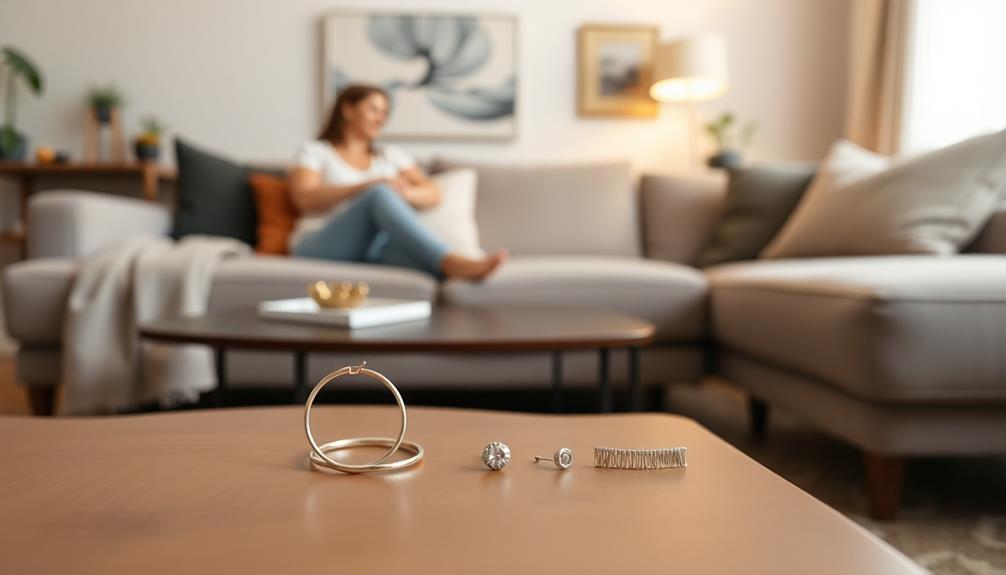When you want to discuss your desire for piercings with conservative family members, approach the conversation thoughtfully. Start by acknowledging their concerns about societal perceptions and potential judgments. Use "I" statements to express your feelings clearly without sounding confrontational. Share personal anecdotes that highlight your self-confidence and individuality. Choose a calm moment to foster open dialogue, and listen actively to their viewpoints. Validate their feelings to show respect, while emphasizing the evolving nature of body art in society. If you're curious about more effective strategies for these discussions, there's much more to explore!
Key Takeaways
- Prepare for emotional reactions by actively listening and acknowledging your family's feelings about piercings.
- Use "I" statements to express your desire for piercings without sounding accusatory or confrontational.
- Choose an appropriate time for discussions to create a calm and receptive environment for dialogue.
- Highlight changing societal norms and share personal anecdotes to illustrate self-confidence and individuality.
- Address professionalism concerns by discussing tasteful jewelry options that align with family preferences.
Understanding Family Concerns

Understanding family concerns about piercings can be challenging, but it's essential for open dialogue. Many family members worry about how society perceives piercings, fearing potential prejudice in professional settings. They want to protect young people from facing bias that could hinder future opportunities. This protective instinct often stems from a place of love, even if it feels restrictive.
For conservative family members, piercings might symbolize rebellion or non-conformity, triggering strong emotional reactions. Personal beliefs, including religious views, can also shape their stance, leading to passionate discussions about what's appropriate or moral.
When addressing these taboo subjects, it's vital to recognize the different levels of acceptance within family dynamics. Some members may embrace body modifications, while others may resist them, creating friction during conversations.
Preparing for Conversations

Before you talk about piercings, think about how your family might react emotionally and try to find common ground.
It's important to listen actively and acknowledge their feelings while sharing your perspective.
This way, you can create a more understanding and respectful dialogue.
Anticipate Emotional Reactions
Often, family members may react strongly when you bring up the topic of piercings, especially if they hold conservative beliefs. Almost every conversation about piercings can trigger strong emotional responses, as these beliefs often stem from cultural, religious, or traditional values.
Be prepared for potential expressions of disappointment or concern, particularly regarding societal judgments tied to job interviews and professional opportunities. It's important to approach this conversation with clear communication during a breakup to minimize misunderstandings and maintain a respectful dialogue.
Initial shock or disapproval can lead to defensive reactions, so patience and empathy are essential. They might ask why you want piercings, and it's important to explain that they represent self-expression and individuality for you.
Acknowledge that your family has emotional investments in maintaining their traditional values, and show respect for their perspectives, even while asserting your own choices.
Establish Common Ground
Next, highlight how societal norms around body modifications are changing. Many people today view piercings as a form of self-expression, not rebellion.
This perspective can help your family see piercings in a new light, similar to how individuals often navigate complex relationships with narcissistic partners and seek to assert their identities.
Share personal anecdotes about how piercings have boosted your self-confidence and individuality. Relating your experience to theirs can foster empathy and understanding.
It's also important to address concerns about professionalism. Emphasize that your choices, including piercings, don't diminish your commitment to family values or future responsibilities.
Remind them that people in various professions express themselves through body art without compromising their work ethic.
Practice Active Listening
During your conversations about piercings, practicing active listening can make a significant difference in how your family perceives your choices. By fully concentrating on what your family members are saying, you'll better understand their concerns and can address them effectively.
Paraphrasing or summarizing their points shows that you value their perspective, which often reduces defensiveness.
Encourage dialogue by asking open-ended questions. This invites your family to express their feelings and opinions, creating a more inclusive discussion.
While you're talking, maintain eye contact and use nonverbal cues like nodding to demonstrate engagement and respect. These actions help build a connection and show you're genuinely interested in their thoughts.
Lastly, practice patience and allow pauses for reflection. Some family members may need time to process the idea of piercings before responding. Giving them that space can lead to deeper insights and understanding.
Strategies for Open Dialogue

When you talk about piercings, start with "I" statements to share your feelings and desires, like saying, "I feel that piercings are a meaningful form of self-expression for me."
Make sure to actively listen to your family's concerns, validating their feelings to show you respect their perspectives.
Choosing the right time for these discussions can really help create a more open and understanding atmosphere.
Use "I" Statements
Using "I" statements can transform a potentially tense conversation about piercings into a more open and understanding dialogue. By expressing your feelings and desires without sounding accusatory, you create a space for genuine discussion.
For instance, instead of saying, "You don't understand my choices," try, "I feel that getting a piercing is a form of self-expression for me." This approach helps reduce defensiveness in your family members.
Additionally, framing your discussion around personal experiences can foster empathy. You might say, "I've seen how piercings can enhance individuality in my friends," which makes your perspective more relatable.
It's crucial to stay calm and composed when using "I" statements; this will help maintain a respectful and constructive conversation, even if emotions run high.
Preparing for potential objections is also wise. Anticipate their concerns and respond thoughtfully, like saying, "I understand that you may worry about perceptions, and I appreciate your concern."
This shows you're willing to engage and consider their feelings, paving the way for a more productive dialogue about your desire for piercings.
Active Listening Techniques
After expressing your feelings with "I" statements, it's important to engage in active listening to foster a constructive dialogue about piercings. Start by maintaining eye contact and nodding during the conversation. This shows your family that you value their perspective, which can help reduce tension.
When they share their concerns, paraphrase what they say to demonstrate your understanding. For example, you might say, "I hear that you worry about how my piercings might affect my future job opportunities." This technique reassures them that you're genuinely listening.
Make sure to avoid interrupting while they speak. Instead, wait for them to finish before responding. This practice respects their viewpoint and encourages an open exchange of ideas.
Additionally, ask open-ended questions like, "What are your thoughts on piercings and their significance?" This invites them to share their opinions and fosters a two-way conversation.
Navigating Sensitive Topics

Steering through sensitive topics like piercings requires a thoughtful approach, especially with family members who might hold traditional views. Start by acknowledging their perspectives and understand that these discussions can evoke strong emotions. Patience and understanding are key here.
Before diving into your desire for piercings, highlight common ground. Emphasize shared values that can create a more receptive atmosphere for dialogue. For instance, if your family values self-expression, relate your desire for piercings to that principle.
Using relatable examples or personal experiences can also help bridge the gap. Share stories that illustrate why piercings are meaningful to you, making it easier for them to grasp your perspective.
Be prepared for potential objections. Anticipating their concerns allows you to respond respectfully, fostering a constructive conversation instead of a confrontational one.
Timing matters too. Choose appropriate moments, like during calm family gatherings, when everyone is more open to discussing sensitive topics. This can greatly enhance the chances of a productive dialogue about your desire for piercings.
Choosing Appropriate Jewelry

When it comes to choosing appropriate jewelry for your piercings, the right selection can make a significant difference in how your family perceives them. Opting for high-quality, elegant pieces can help counter negative stereotypes and present your piercings as sophisticated.
Here are three suggestions to keep in mind:
- Classic Designs: Choose simple studs or hoops that are more palatable to traditional views. These timeless styles can demonstrate maturity and a thoughtful approach to your choices.
- Piercing Retainers: Consider using discreet retainers during family gatherings. This way, you can maintain your piercings without drawing unwanted attention, minimizing potential discomfort or disapproval from relatives.
- Tasteful Aesthetics: Align your jewelry with your family members' aesthetic preferences. Opt for understated pieces that reflect a sense of personal expression while still respecting their tastes.
Engaging in discussions about the craftsmanship and artistic value of your chosen jewelry can also help family members see your piercings as a legitimate form of self-expression rather than mere rebellion.
Building a Support System

Finding a supportive environment is key to guiding family conversations about your piercings. Start by seeking out friends or allies who share similar experiences. They can offer insights and strategies that help you approach your conservative family members more effectively.
Consider joining local or online communities focused on body modifications. These groups provide valuable support and resources, directing you through family discussions.
You might also explore therapy or counseling services. They can help you understand your feelings better and develop effective communication skills before tackling family conversations.
Connecting with local LGBTQ+ organizations can be beneficial too. They often provide tailored resources and advice for individuals addressing acceptance issues regarding personal expression.
Don't underestimate the power of social media, either. Engage with platforms that promote supportive content around body modifications. This can serve as a great conversation starter and help normalize discussions about piercings.
Frequently Asked Questions
How Can I Ensure My Piercings Are Safe and Hygienic?
To guarantee your piercings are safe and hygienic, always choose a professional piercer, use sterile equipment, and follow aftercare instructions. Clean the area regularly, avoid touching, and don't remove jewelry too early.
What Types of Piercings Are Considered More Acceptable by Conservative Family Members?
When considering piercings, think of them like choosing a book cover. Subtle options, like earlobe or cartilage piercings, might be more acceptable. They're classic, just like a timeless novel, appealing to conservative tastes.
How Can I Handle Resistance or Backlash From Family During the Conversation?
When you face resistance, stay calm and listen. Acknowledge their concerns, and share your feelings honestly. Emphasize that your choices reflect your identity, not a rejection of family values. Open dialogue fosters understanding.
What Age Is Appropriate for Getting Piercings Without Parental Consent?
Most states allow you to get piercings without parental consent at 18. However, some places permit it earlier with specific regulations. It's crucial to check local laws and consider your personal situation before deciding.
How Can I Explain the Cultural Significance of Piercings to My Family?
You can explain that piercings often symbolize personal expression, cultural heritage, or rites of passage. Share stories from different cultures, emphasizing their significance. This might help your family understand the importance behind your desire for piercings.
Conclusion
Ultimately, discussing your desire for piercings with your conservative family members can feel intimidating, but remember, it's about expressing your individuality. They may worry about your safety or future prospects, but reassure them that you're informed and responsible. Highlight that piercings can be done safely and with care, reflecting your personal style without compromising your values. By fostering open dialogue, you can bridge the gap between your desires and their concerns, creating a space for understanding.
Hi, my name is Danielle, and I’m an author for piercings-body.com. I have a passion for writing and love to share my knowledge on all things body piercing-related. I’m also a huge advocate for safe body modification practices and believe everyone should be able to make informed decisions about their bodies. When I’m not writing or blogging, I enjoy spending time with my family and friends, practicing yoga, and exploring new places.

















